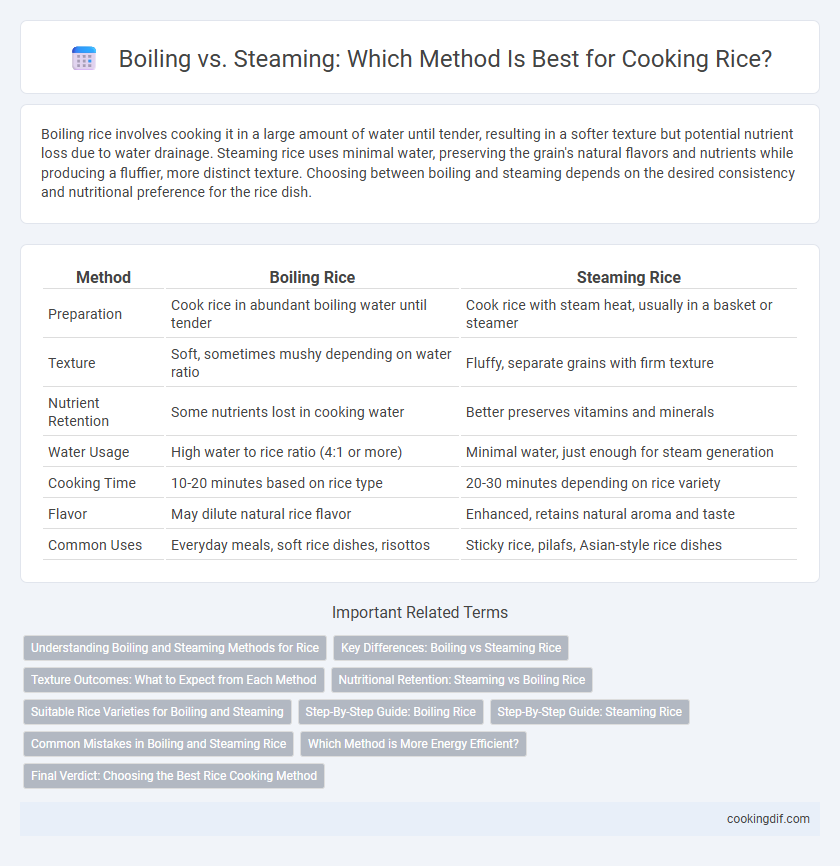Boiling rice involves cooking it in a large amount of water until tender, resulting in a softer texture but potential nutrient loss due to water drainage. Steaming rice uses minimal water, preserving the grain's natural flavors and nutrients while producing a fluffier, more distinct texture. Choosing between boiling and steaming depends on the desired consistency and nutritional preference for the rice dish.
Table of Comparison
| Method | Boiling Rice | Steaming Rice |
|---|---|---|
| Preparation | Cook rice in abundant boiling water until tender | Cook rice with steam heat, usually in a basket or steamer |
| Texture | Soft, sometimes mushy depending on water ratio | Fluffy, separate grains with firm texture |
| Nutrient Retention | Some nutrients lost in cooking water | Better preserves vitamins and minerals |
| Water Usage | High water to rice ratio (4:1 or more) | Minimal water, just enough for steam generation |
| Cooking Time | 10-20 minutes based on rice type | 20-30 minutes depending on rice variety |
| Flavor | May dilute natural rice flavor | Enhanced, retains natural aroma and taste |
| Common Uses | Everyday meals, soft rice dishes, risottos | Sticky rice, pilafs, Asian-style rice dishes |
Understanding Boiling and Steaming Methods for Rice
Boiling rice involves cooking grains in abundant water until tender, effectively washing away excess starch but potentially leading to nutrient loss. Steaming rice uses minimal water and preserves the rice's natural texture and nutrients by cooking it through steam heat. Choosing between boiling and steaming impacts rice's firmness, flavor retention, and overall nutritional quality.
Key Differences: Boiling vs Steaming Rice
Boiling rice involves submerging grains in excess water, leading to faster cooking but potential nutrient loss and softer texture. Steaming rice uses minimal water, preserving nutrients and yielding firmer, fluffier grains with distinct texture. The choice depends on desired consistency, nutrient retention, and cooking speed preferences.
Texture Outcomes: What to Expect from Each Method
Boiling rice results in a softer, more pliable texture as the grains absorb ample water, often leading to slight stickiness or clumping. Steaming preserves the rice's structure, producing firmer, separate grains with a fluffy consistency due to gentle, indirect heat and controlled moisture. Choosing between boiling and steaming impacts the final dish's texture, essential for recipes requiring distinct grain separation or creamy consistency.
Nutritional Retention: Steaming vs Boiling Rice
Steaming rice preserves more vitamins and minerals compared to boiling, as the grains remain intact without leaching nutrients into the water. Boiling rice often results in significant nutrient loss, especially water-soluble vitamins like B-complex and antioxidants. Steamed rice retains higher levels of essential nutrients, making it a more nutritious cooking method.
Suitable Rice Varieties for Boiling and Steaming
Long-grain rice varieties such as basmati and jasmine are ideal for boiling due to their firm texture and ability to separate easily after cooking. Short-grain and medium-grain rice types, including sushi rice and arborio, respond better to steaming as this method preserves their sticky and creamy consistency. Understanding the intrinsic starch composition of each rice variety helps determine whether boiling or steaming will yield the best texture and flavor.
Step-By-Step Guide: Boiling Rice
Boiling rice involves rinsing grains thoroughly to remove excess starch, then adding rice to a pot with a precise water-to-rice ratio, typically 2:1 for white rice. Bring the water to a boil over high heat, then reduce to a simmer, covering the pot to ensure even cooking. After about 15-20 minutes, remove from heat and let the rice sit covered for 5-10 minutes to absorb residual steam, resulting in fluffy, separate grains ideal for various dishes.
Step-By-Step Guide: Steaming Rice
Steaming rice preserves more nutrients and delivers a fluffier texture compared to boiling by cooking rice evenly with indirect heat. Start by rinsing 1 cup of long-grain rice under cold water to remove excess starch, then soak it for 30 minutes to ensure even cooking. Place the soaked rice in a steamer basket over boiling water, cover tightly, and steam for 20-25 minutes until grains are tender and fully hydrated.
Common Mistakes in Boiling and Steaming Rice
Overboiling rice often leads to mushy, waterlogged grains due to excessive water absorption and continuous heat exposure, while underboiling results in hard, undercooked kernels. Steaming mistakes include insufficient soaking or uneven steam distribution, causing inconsistent texture and partially uncooked rice. Precise water-to-rice ratio, consistent temperature control, and adequate resting time are critical for perfect rice in both boiling and steaming methods.
Which Method is More Energy Efficient?
Steaming rice uses less water and consumes less energy compared to boiling, as it relies on indirect heat to cook the grains evenly without constant boiling. Boiling requires maintaining a rolling boil and subsequent draining, leading to higher water and energy use. Energy-efficient rice cookers often utilize steaming principles to optimize cooking time and reduce power consumption.
Final Verdict: Choosing the Best Rice Cooking Method
Steaming rice preserves more nutrients and delivers a fluffier texture compared to boiling, which often causes nutrient loss through water absorption. Boiling is faster and ideal for recipes requiring softer, stickier rice varieties like sushi rice. For optimal taste and nutrition, steaming reigns as the preferred rice cooking method, especially for long-grain and aromatic rice types.
Boiling vs steaming for rice preparation Infographic

 cookingdif.com
cookingdif.com